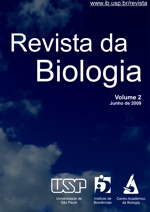Physiology of music: a comparative approach
DOI:
https://doi.org/10.11606/issn.1984-5154.v2p12-17Keywords:
Music, neuroscience, comparative physiologyAbstract
Around the world in many different cultures, you can find people producing or enjoying music. Still, we cannot tell consensualy if there is any adaptive advantages in music and why it is distributed around the globe unrestrictedly. Was Darwin right in suggesting that music comes from ancient times, with our ancestors? But what about other species? Can they produce or enjoy music? If yes, for pleasure/art, as appears to be for man, or as simple instinct? The evidences for answering these questions begin to be found. We here review the neurophysiological mechanisms that allow the existence of music for man and in what ways it manifests itself in other species.
Downloads
References
Baptista, L.F.; Keister, R. Why Bird Song Is Sometimes Like Music, BioMusic Symposium, AAAS ANNUAL MEETING, 2000. apud GRAY e colaboradores - The Music of Nature and the Nature of Music. Science, v.291, n.5501, p.52-54, jan. 2001.
Bendor, D.; Wang, X. - Cortical representations of pitch in monkeys and humans. Curr Opin Neurobiol. 16(4):391-9. 2006.
Bendor, D.; Wang, X. - The neuronal representation of pitch in primate auditory cortex. Nature, v. 436, n.25, p.1161-1165, ago. 2005.
Benítez-Bribiesca, L. The Biology of Music. Science. v.292, n.5526, p.2432-2433, Jun. 2001.
Clark, X. Animal music, its nature and origin. The American Naturalist, v.13, n.4, p.209-223, abr. 1879.
Darwin, C. The descent of man, and selection in relation to sex. 2. ed. New York: Hurst & Company. 1874. apud PINKER, S. How the mind works. 1.ed. London: Penguin Books, 1998. 660p.
Gess, A. Birds like music, too. Science, v.317, n.5864, p.1864, set. 2007.
Gray, P.M.; Krause, B.; Atema, J.; Payne, R.; Krumhansl, C.; Baptista, L. The Music of Nature and the Nature of Music. Science, v.291, n.5501, p.52-54, jan. 2001.
Hauser, M. D.; Mcdermott, J. The evolution of the music faculty: a comparative perspective. Nat Neurosci. v.6, n.7, p.663-668, jul. 2003.
Koelsch, S.; Kasper, E.; Sammler, D.; Schulze, K.; Gunter, T.; Friederici, A.D. Music, language and meaning: Brain signatures of semantic processing. Nat Neurosci, v.7, n.3, p.302-307, mar. 2004.
Masataka, N. Music, evolution and language. Developmental Science, v.10, n.1, p.35-39, jan. 2007.
Meyer, R. B. Emotion and meaning in music. 1956. Chicago: University of Chicago Press apud TRAINOR, L.J.; HEINMILLER, B.M. Infants prefer to listen to consonance over dissonance. Inf. Behav. Dev. 1998 21, 77-88.
Patel, A.D. Language, music, syntax and the brain. Nat Neurosci, v.6, n.7, p.674-681, jul. 2003a.
Patel, A.D. Rhythm in language and music: parallels and differences. Ann NY Acad Sci, v.999, p.140-143. Dez. 2003b.
Payne, R. Whale Songs: Musicality or Mantra? BioMusic Symposium, AAAS Annual Meeting, 2000. apud GRAY e colaboradores - The Music of Nature and the Nature of Music. Science, v.291, n.5501, p.52-54, jan. 2001.
Pinker, S. How the mind works. 1.ed. London: Penguin Books, 1998. 660p.
Porres, A. T. Processos de Composição Microtonal por meio do Modelo de Dissonância Sensorial. 2007. 189 p. Dissertação (Mestrado) – Instituto de Artes, Universidade Estadual de Campinas, Campinas.
Samson, S. Neuropsychological studies of musical timbre. Ann NY Acad Sci, v.999, p.144-151, dez. 2003.
Sethares, W.A. Relating tuning and timbre. Disponível em: http://eceserv0.ece.wisc.edu/~sethares/consemi.html. Acesso em: 13/03/2009.
Suits, B.H. Physics of music – notes. Disponível em: http://www.phy.mtu.edu/~suits/overtone.html. Acesso em: 13/03/2009.
Trainor, L.J.; Heinmiller, B.M. Infants prefer to listen to consonance over dissonance. Inf. Behav. Dev. 1998 21, 77-88.
Tramo, M.J. Music of the Hemispheres. Science, v.291, n.5501, p.54-56, jan. 2001.
Trehub, S.E.; Hannon, E.E. Infant music perception: domain-general or domain-specific mechanisms? Cognition, v.100, n.1, p.73-99, Mai. 2006.
Wright, A.A.; Rivera, J.J.; Hulse, S.H.; Shyan, M.; Neiworth, J.J. Music perception and octave generalization in rhesus monkeys. J Exp Psychol Gen. v.129, n.3, p.291-307, set. 2000.
Zatorre, R.J. Finding the missing fundamental. Nature, v.436, n.25, p.1093-1094, Ago. 2005.
Zatorre, R.J. Music and the Brain. Annals N Y A Scien, v.999, p.4-14, dez. 2003.
Downloads
Published
Issue
Section
License
Copyright (c) 2009 Felipe V. Rodrigues

This work is licensed under a Creative Commons Attribution 4.0 International License.
We ensure that our journal does not retain any copyright and that these are exclusive of the author(s) of the text. In that sense, we intend to break any restrictions to the published material and to achieve more intensely our goal of communicating science.






